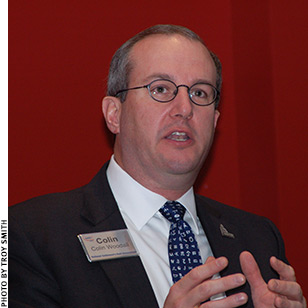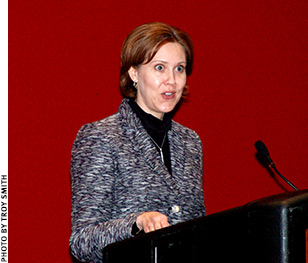Cattle Marketing & International Trade
Committee updated on CME trading, mandatory price reporting and international trade.
SAN ANTONIO, Texas (Feb. 6, 2015) — The National Cattlemen’s Beef Association (NCBA) Cattle Marketing & International Trade Committee met Feb. 6 during the 2015 Cattle Industry Convention in San Antonio, Texas. Committee chairman and Iowa cattleman Ed Greiman called the agenda “largely educational” and introduced, in turn, several guest speakers.
 NCBA Vice President of Public Affairs Colin Woodall reported that mandatory price reporting — the law requiring large packers and importers to report transactions — will expire as of Sept. 30, 2015.
NCBA Vice President of Public Affairs Colin Woodall reported that mandatory price reporting — the law requiring large packers and importers to report transactions — will expire as of Sept. 30, 2015. Among the guests invited to address committee members was Tim Andriesen, representing the CME group. Andriesen explained how open outcry trading has been permanently suspended for most futures trade. The decision followed a long period of decline, to where less than 1% of contracts were traded on the CME floor and the overwhelming majority of trade was performed electronically. Andriesen also noted the addition of a fed-heifer contract, with trading set to begin in August 2015.
Rob Johnson, Western Futures brokerage and order-buying company, reported how the CME feeder-cattle index is based on direct reports of weekly feeder-cattle trade. However, large numbers of cash transactions are negotiated daily but not included in the calculation of the index. Johnson asked that NCBA consider studying the advantages of voluntary reporting of cash feeder-cattle transactions to USDA in order to strengthen the feeder-cattle index.
NCBA Vice President of Public Affairs Colin Woodall reported that mandatory price reporting — the law requiring large packers and importers to report transactions — will expire as of Sept. 30, 2015. Woodall said NCBA will push for reauthorization for another five years.
 Darci Vetter reported full access for U.S. beef to the Hong Kong market and the slow but continuing recovery of the Japanese market.
Darci Vetter reported full access for U.S. beef to the Hong Kong market and the slow but continuing recovery of the Japanese market. Also present to address committee members was Darci Vetter, chief agricultural negotiator for the U.S. Trade Representative. Vetter explained advantages associated with the Trans-Pacific Partnership (TPP) trade agreement, calling it an ambitious endeavor involving 12 nations.
“It’s important to the U.S. to gain improved access and more harmonious trade rules in a part of the world representing 40% of the global economy,” said Vetter, noting the potential for this agreement to grow U.S. exports by $123.5 billion. “The U.S. could gain the advantage of lower tariffs and increased access to markets for agricultural products, including beef.”
Vetter also reported full access for U.S. beef to the Hong Kong market and the slow but continuing recovery of the Japanese market.
Editor’s Note: The articles used within this site represent a mixture of copyrights.This article was written by staff or under contract for the Angus Journal. If you would like to reprint or repost an article, you must first request permission of the Angus Journal by contacting the editor at 816-383-5200; 3201 Frederick Ave., Saint Joseph, MO 64506. The Angus Journal claims copyright to this website as presented. We welcome educational venues and cattlemen to link to this site as a service to their audience.

